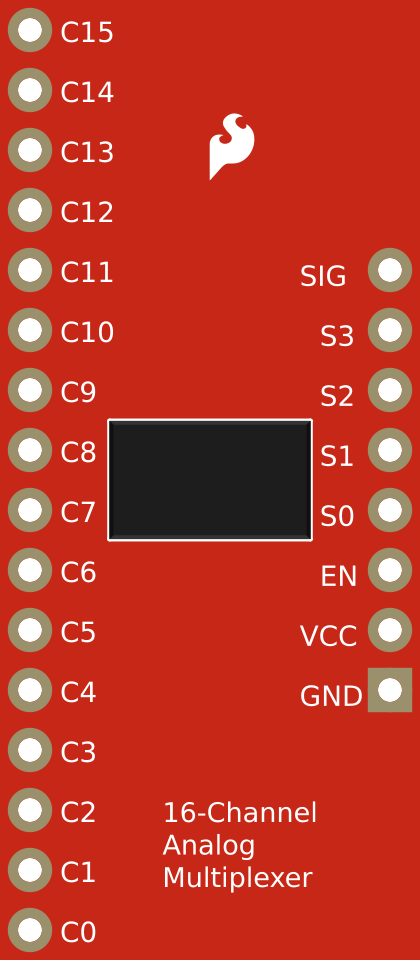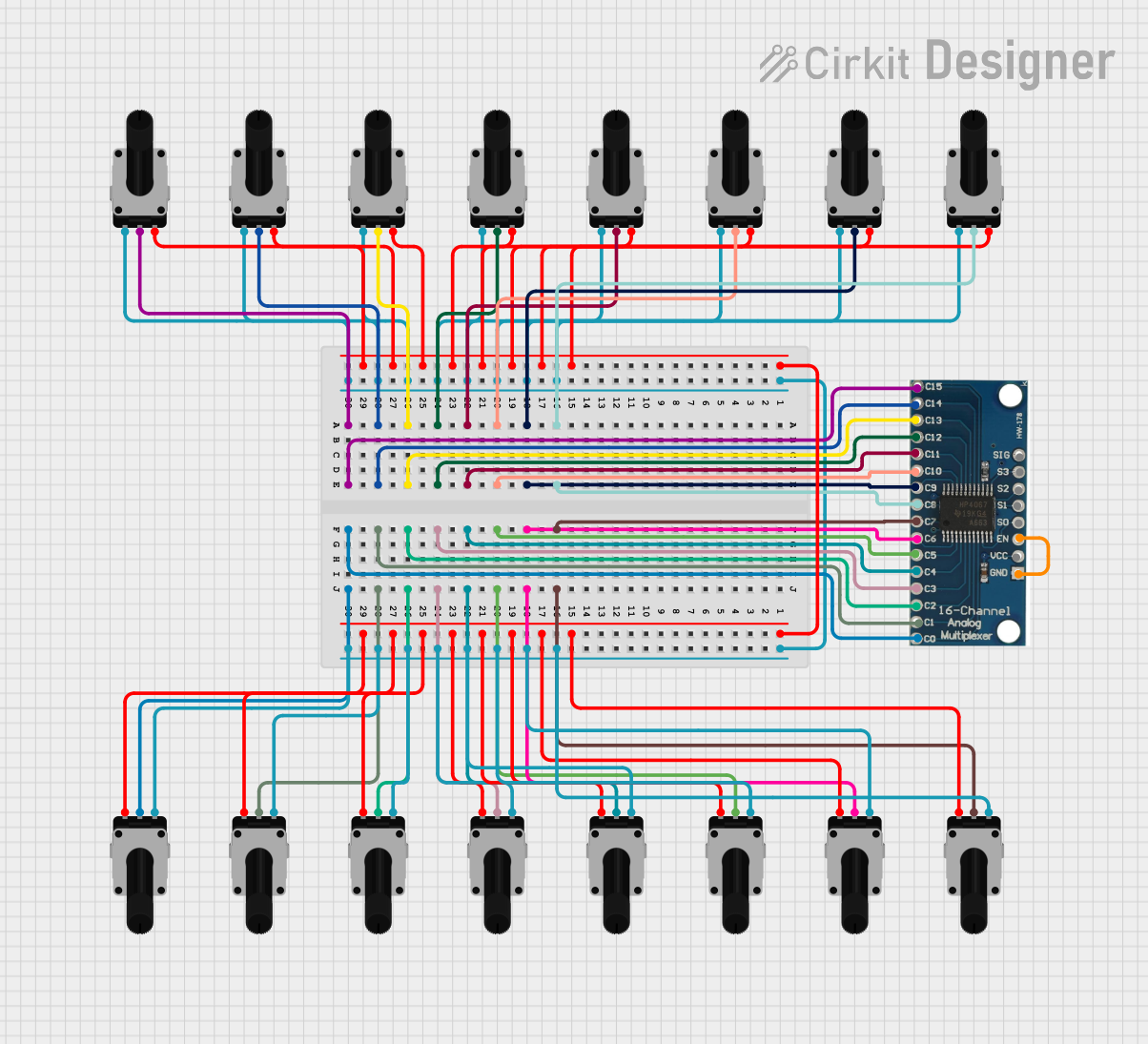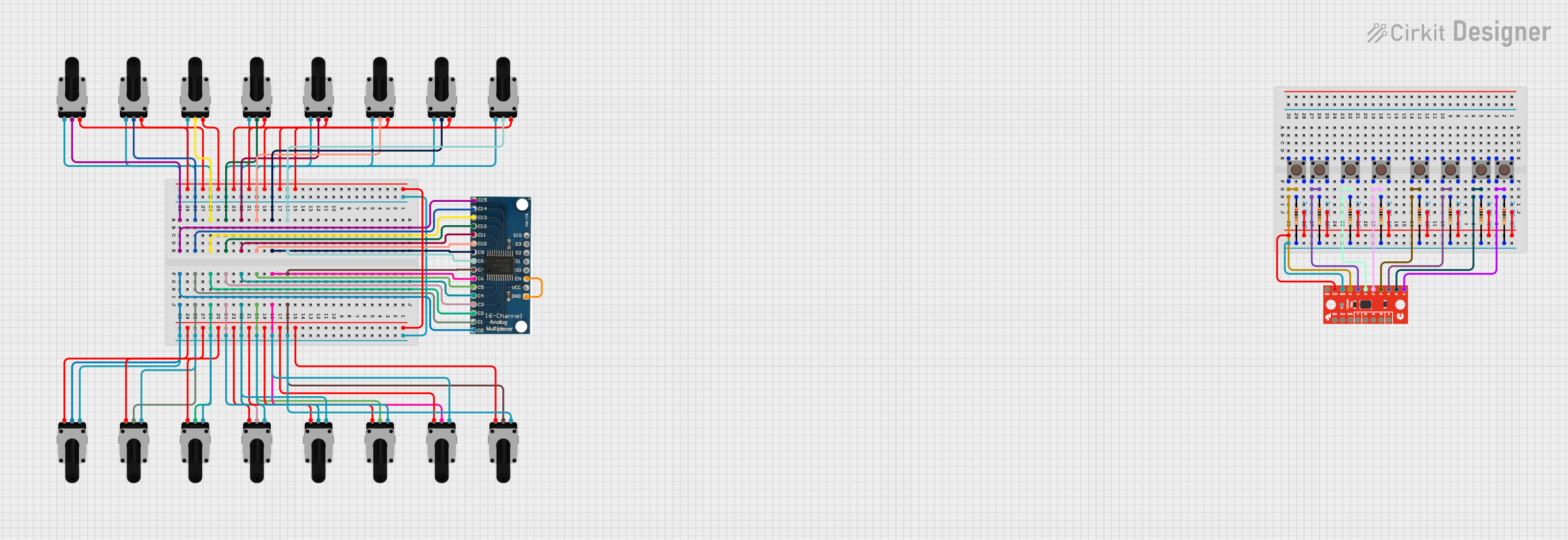
How to Use 16 - Channel Analog Multiplexer: Examples, Pinouts, and Specs

 Design with 16 - Channel Analog Multiplexer in Cirkit Designer
Design with 16 - Channel Analog Multiplexer in Cirkit Designer16-Channel Analog Multiplexer Documentation
1. Introduction
The 16-Channel Analog Multiplexer is a versatile electronic component designed to route one of 16 analog input signals to a single output channel. This device is controlled using digital selection signals, allowing users to dynamically choose which input is connected to the output. It is widely used in applications where multiple analog signals need to be processed or monitored but only one analog-to-digital converter (ADC) is available.
Common Applications:
- Signal routing in data acquisition systems
- Expanding the number of analog inputs for microcontrollers (e.g., Arduino, Raspberry Pi)
- Audio signal switching
- Sensor multiplexing in IoT devices
- Test and measurement equipment
2. Technical Specifications
The following table outlines the key technical details of a typical 16-Channel Analog Multiplexer, such as the CD74HC4067 or 74HC4067:
| Parameter | Value |
|---|---|
| Supply Voltage (Vcc) | 2V to 6V |
| Input Voltage Range | 0V to Vcc |
| Control Logic Voltage | 0V to Vcc |
| On-Resistance (RON) | ~70Ω at 5V |
| Maximum Current (IOUT) | ±25mA |
| Propagation Delay | ~6ns at 5V |
| Operating Temperature | -55°C to +125°C |
| Package Types | DIP, SOIC, TSSOP |
Pin Configuration and Descriptions
The 16-Channel Analog Multiplexer typically has 24 pins. Below is the pinout description:
| Pin Name | Pin Number | Description |
|---|---|---|
| S0 | 10 | Selection pin 0 (LSB of the control signal) |
| S1 | 11 | Selection pin 1 |
| S2 | 13 | Selection pin 2 |
| S3 | 14 | Selection pin 3 (MSB of the control signal) |
| EN (Enable) | 15 | Active LOW enable pin. When HIGH, all channels are disconnected. |
| COM (Common) | 1 | Common I/O pin. Connects to the selected input channel. |
| IN0–IN15 | 2–9, 16–23 | Analog input channels. IN0 corresponds to S3S2S1S0 = 0000, IN15 to 1111. |
| Vcc | 24 | Positive power supply |
| GND | 12 | Ground |
3. Usage Instructions
Connecting the Multiplexer to a Circuit
Power Supply:
- Connect the Vcc pin to a voltage source (e.g., 5V for Arduino).
- Connect the GND pin to the ground of your circuit.
Control Pins:
- Use four digital pins from your microcontroller to control the selection pins (S0–S3).
- The binary value on these pins determines which input channel (IN0–IN15) is routed to the common pin (COM).
Enable Pin:
- Connect the EN pin to ground (LOW) to enable the multiplexer.
- If you want to disable the multiplexer, set the EN pin HIGH.
Analog Inputs:
- Connect your analog signals to the input pins (IN0–IN15).
Common Pin:
- Connect the COM pin to the analog input of your microcontroller or ADC.
Example Circuit with Arduino UNO
Below is an example of how to connect the 16-Channel Analog Multiplexer to an Arduino UNO:
- Vcc → 5V on Arduino
- GND → GND on Arduino
- S0–S3 → Digital pins 2, 3, 4, 5 on Arduino
- EN → GND
- COM → A0 (Analog pin 0 on Arduino)
- IN0–IN15 → Sensors or other analog signals
Example Arduino Code
The following Arduino code demonstrates how to read from multiple analog inputs using the multiplexer:
// Define control pins for the multiplexer
const int S0 = 2; // Selection pin 0
const int S1 = 3; // Selection pin 1
const int S2 = 4; // Selection pin 2
const int S3 = 5; // Selection pin 3
// Define the common pin connected to Arduino's analog input
const int COM = A0;
// Function to set the multiplexer channel
void selectChannel(int channel) {
// Set the state of each selection pin based on the channel number
digitalWrite(S0, channel & 0x01); // LSB
digitalWrite(S1, (channel >> 1) & 0x01);
digitalWrite(S2, (channel >> 2) & 0x01);
digitalWrite(S3, (channel >> 3) & 0x01); // MSB
}
void setup() {
// Initialize the selection pins as outputs
pinMode(S0, OUTPUT);
pinMode(S1, OUTPUT);
pinMode(S2, OUTPUT);
pinMode(S3, OUTPUT);
// Initialize serial communication for debugging
Serial.begin(9600);
}
void loop() {
// Loop through all 16 channels
for (int channel = 0; channel < 16; channel++) {
selectChannel(channel); // Select the current channel
delay(10); // Small delay for signal stabilization
// Read the analog value from the selected channel
int value = analogRead(COM);
// Print the channel number and its value
Serial.print("Channel ");
Serial.print(channel);
Serial.print(": ");
Serial.println(value);
}
delay(1000); // Wait 1 second before the next reading cycle
}
4. Best Practices and Considerations
- Signal Integrity: Avoid long wires for analog signals to minimize noise and signal degradation.
- Power Supply Decoupling: Place a 0.1µF capacitor near the Vcc pin to reduce power supply noise.
- Unused Inputs: Connect unused input channels to ground to prevent floating signals.
- Enable Pin: Use the enable pin to disconnect all channels when the multiplexer is not in use.
5. Troubleshooting and FAQs
Common Issues and Solutions
| Issue | Possible Cause | Solution |
|---|---|---|
| No signal at the COM pin | EN pin is HIGH | Ensure the EN pin is connected to GND (LOW). |
| Incorrect channel selected | Control pins not set correctly | Verify the binary value on S0–S3 matches the desired channel. |
| Signal distortion or noise | Long wires or poor grounding | Use shorter wires and ensure a proper ground connection. |
| Weak or no signal from input channel | Input signal is too weak or disconnected | Check the input signal source and ensure proper connection to the input pin. |
FAQs
Can I use the multiplexer for digital signals?
- Yes, the multiplexer can route digital signals as well as analog signals.
What happens if multiple input channels are active?
- Only one channel is routed to the COM pin at a time, based on the control signals.
Can I cascade multiple multiplexers?
- Yes, you can cascade multiple multiplexers to expand the number of input channels.
What is the maximum frequency the multiplexer can handle?
- The maximum frequency depends on the on-resistance and capacitance of the device. For most applications, it can handle signals up to a few MHz.
This documentation provides a comprehensive guide to using the 16-Channel Analog Multiplexer effectively. Whether you're a beginner or an experienced user, this guide will help you integrate the multiplexer into your projects with ease.
Explore Projects Built with 16 - Channel Analog Multiplexer

 Open Project in Cirkit Designer
Open Project in Cirkit Designer
 Open Project in Cirkit Designer
Open Project in Cirkit Designer
 Open Project in Cirkit Designer
Open Project in Cirkit Designer
 Open Project in Cirkit Designer
Open Project in Cirkit DesignerExplore Projects Built with 16 - Channel Analog Multiplexer

 Open Project in Cirkit Designer
Open Project in Cirkit Designer
 Open Project in Cirkit Designer
Open Project in Cirkit Designer
 Open Project in Cirkit Designer
Open Project in Cirkit Designer
 Open Project in Cirkit Designer
Open Project in Cirkit Designer